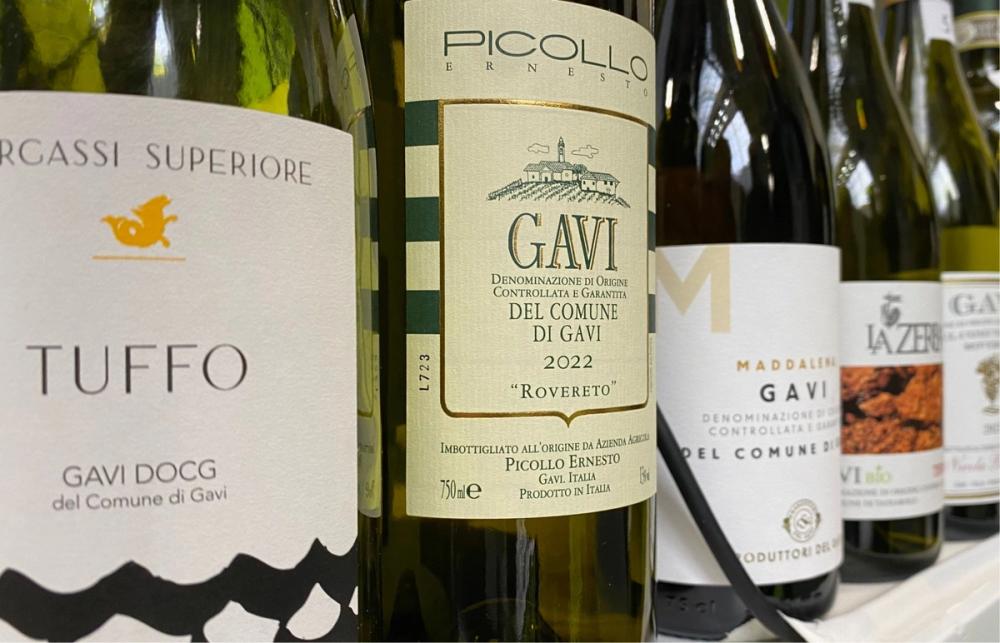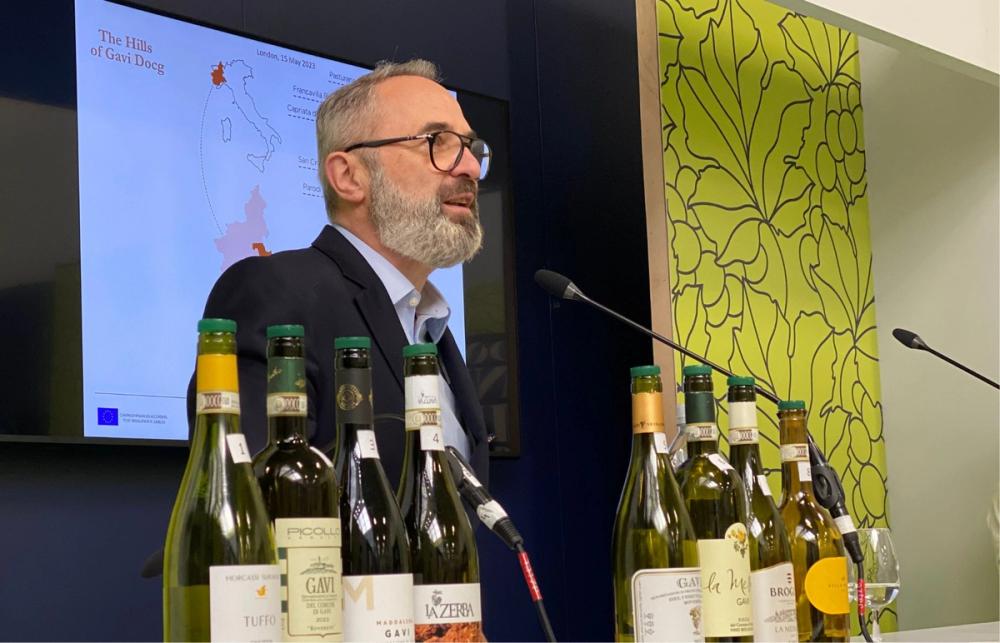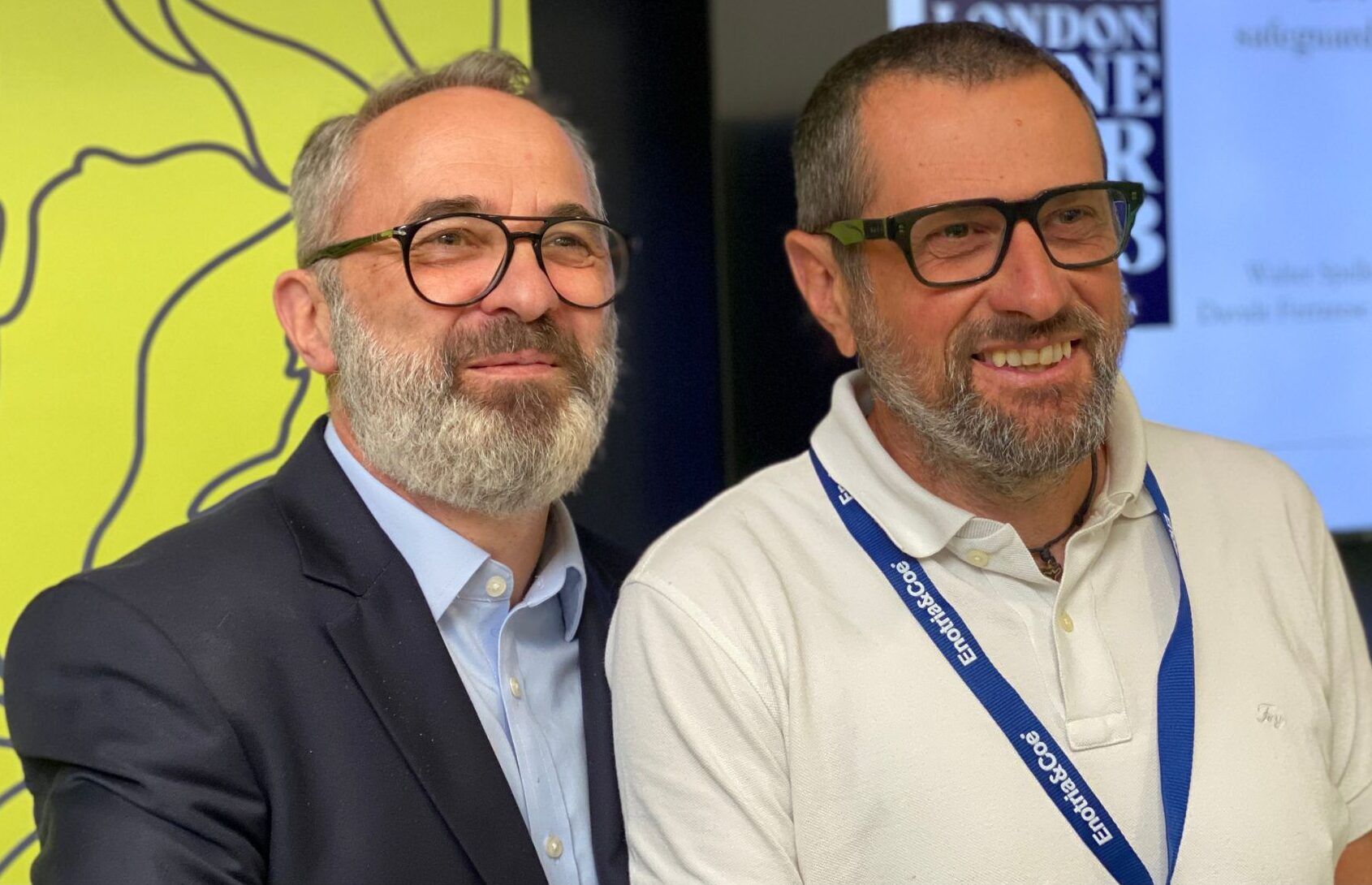“Gavi wines are often thought of as neutral, but that’s simply not true, you just need to pay a bit more. From about £15 retail you can find some beautiful wines,” says Speller.

An impressive line-up of Gavi at the London Wine Fair masterclass
The changing climate, whether that be our efforts to slow those changes or adapt to those that are already here, will dominate the wine industry as a topic of concern for years to come. Vineyards are often referred to as the ‘canary in the cage’ of climate change in agriculture, with many wine regions having built their reputations on wine styles and terroir that are changing before our eyes.
It can be argued that those regions whose reputation is built on producing clean, refreshing white wines are particularly in the spotlight. How can an area like north-west Italy’s Gavi region possibly cope with increasingly erratic weather patterns and higher average temperatures and still produce the fresh, light, thirst quenching wines we all know and love?
That was the question both asked and argued by the Consorzio Tutela del Gavi’s chief agronomist, Davide Ferrarese, and JancisRobinson.com’s Italian editor, Walter Speller at a recent masterclass at the London Wine Fair.
Over the course of 60 minutes, and a host of excellent wines, the pair addressed the impact of climate change on Gavi, how it alters its grape variety Cortese, and what agronomists can do and are doing to combat the challenges faced.
So what do we know about Gavi?

Gavi: In the face of a warming climate, having one famous wine style that relies on freshness and subtle flavours presents a problem.
First thing’s first, let’s find our context. Gavi is a region in north-west Italy in Piemonte. Although an area of the country famed for its reds from the hills of Barolo and Barbaresco, the white wines of Gavi have long held their own on the wine shelves, providing dry, crisp white wines with fresh acidity, subtle green fruit, citrus and floral notes and usually a good dose of salty minerality.
The wines are made from the Cortese grape, a Piemontese native. Its high yielding nature is tempered by the yield rules of both Gavi DOCG and the Gavi Del Commune Di Gavi DOCG, to ensure that the wines didn’t fall foul of the fate of other white wine regions who went down the ‘rack ‘em and stack ‘em’ route of mass production when the export markets were receptive. The wines of Gavi have, more than most, kept their reputation as good quality whites for the world’s wine lovers.
What issues does Gavi face?
In the face of a warming climate, having one famous wine style that relies on freshness and subtle flavours presents a problem. The Consorzio might be keen to point out that they’re not a one trick pony, and that the dry white wines are not the only game in town, although it may as well be. The so-called tranquillo style covers 99% of production and is usually made to be drunk young, although some modern producers are challenging that notion. The DOCG does allow for Spumante, Frizzante and aged Riserva styles, but at less that 1% of production, most focus is on the effect of climate change on those dry, refreshing, floral tranquillo wines.
Any threat to the production of that style is a huge threat to the entire region. There are, however, as both Ferrarese and Speller pointed out, a series of happy features of Gavi that give the winemakers plenty of hope for the future.
Cortese is the right grape at the right time

Walter Speller in full flow at the Gavi DOCG masterclass, London Wine Fair
The wines of Gavi use 100% Cortese. This is a native grape to the region, with references all the way back to the 10thcentury and throughout the Middle Ages where trade brought wealth to the courts of the Republic of Genoa. This region is so associated with Cortese that its 1,600 hectares make up over 60% of Italy’s entire Cortese plantings.
The Consorzio, since its inception in 1993, has sought to learn as much as possible about why Cortese is so suited to the Gavi region. In 1997 research began in association with the National Research Council in Turin on clonal selection to enhance the quality and to manage the variety’s vigorous growth.
“Native grapes should be better adapted to the region,” began Ferrarese, “but we need data to understand why. Why, for example, does Cortese perform differently to Chardonnay on these slopes, as we see these international varieties suffering more readily than others across the regions?”
The plant and grape also have a few ideal characteristics in order to cope with a warming climate, yet still produce elegant white wines.
“It’s interesting to see how good this grape can be,” mused Ferrarese. “We think Cortese has a real chance due to both its high acidity and its vigorous nature.”
When pressed about how the vigorous nature could help, Speller questioned the global drive for increasing concentration in grapes. “Cortese is vigorous, and yields are usually 40 to 70 hl/ha. People seem obsessed with the idea of higher concentration in grapes but is that always a good thing? The soils round here are good for naturally keeping the yields down anyway, and the natural balance will give the best results.”
As is true in all vineyard regions of the world as the climate warms, harvest times are becoming increasingly critical.
“We’re very interested in the values of TA (total acidity) and sugar accumulation,” revealed Ferrarese. “We can also use our research to find the perfect equilibrium between foliar and fruit growth for each period of that vintage and pass this information onto the grape growers.”
The borderlands of Piemonte
As much as Gavi is a Piemontese region, it’s only just. Gavi is in the far south-east of Piemonte and shares its border with Liguria and its Mediterranean coastline to the south. It was actually part of the historical communications route up from the ports to central Europe and has many medieval towns and villages that owe their inception to an intense period of European trade that flowed through.
We think of Gavi as being one large area with a particular commune in the middle that lends its name to the whole area. But the wine region of Gavi is actually 11 communes spread over gentle rolling hills as the land rises from the Mediterranean sea to the Piemontese Apennines.
The whole area has only 1,600 hectares under vine, with the rest a mix of biodiversity hot spots including woods, fields and pastures that the Consorzio is keen to preserve. Inter-row grassing and cover crops are encouraged, as is organic viticulture, and the Consorzio produces detailed maps of the exposures and sunlight hours for each particular site in order to more carefully manage the viticultural processes.
Since 2018 the Consorzio has been bio-monitoring the vineyards, including an approach to use local bees to help map out the requirements of each site.
“In order to know what to do, we need to collect as much data as possible with relation to the climate,” explained Ferrarese. “The 5 meteo stations across the DOCG give us punctual measurements, and constant analysis lets us know the relative phenolic stages of the Cortese. We see what the climate is doing, what actions to take, and then distribute our findings to all the producers.”
The use of chemical sprays in the past 15 years has decreased dramatically since this top-down approach from the Consorzio.
Maritime influence
The Mediterranean is only 30kms away from where the vineyards begin. It provides what is known as a ‘transitional continental climate’, with long, rigid winters and hot, sunny summers. The coastal wind is the marin and it is funnelled up the valley and the hillsides, bringing freshness and delicacy to the vines and the subsequent wines.
That wonderful salinity this wind provides lifts the delicate aromas meaning that most Gavi wines are full of varietal and terroir-driven flavour.
“At only 30kms to the coast, the grapes can’t help but take on that influence,” attested Speller. “Gavi wines are often thought of as neutral, but that’s simply not true, you just need to pay a bit more. From about £15 retail you can find some beautiful wines.”
Complexity of soils provides options

There are two main soil types across the Gavi DOCG: Terrarossa and Terrabianca
There are two main types of soils across the DOCG that allow for a variety of styles of Gavi wines. The soils across the gentle rolling slopes to the north of the region are called Terrarosa and are dominated by red clay, which are iron-rich alluvial deposits from the network of rivers that flow into either the Mediterranean or the Po basin. The wines from the north tend to be more full-bodied.
The central strip of white clay across the communes of Serravale Scrivia, Gavi and San Cristofano are known as the Terrabianca. This calcareous rock used to be under an ocean but now also alternates between marl and sandstone. Wines from this area have generally less body, but more of the classic minerality of Gavi.
Towards the south, as the region hugs even tighter to the Apeninnes, the altitude of the vines ranges from 400m to up to 1000m. The altitude alone gives a fabulous range of microclimates in order to deliver the desired styles of wines going forward.
The plan is coming together
The Consorzio Tutela del Gavi’s mandate is to give all of its producers the tools and skills to face the future challenges of climate change.
In the short term, the Consorzio needs all stakeholders to employ similar methods, many of which are widely practised today. These include modern, sustainable pest and disease management techniques, canopy and soil management, as well as more precise harvesting and winemaking. This may sound obvious, but it’s the responsibility of the Consorzio to get everyone ‘singing from the same hymn sheet’.
Once there is a general consensus, the plans are to use the research conducted over the last two decades in both the fields and the laboratories. The fully mapped sites can be used to perfect planting systems, rootstocks, and pruning techniques. The data from the meteo stations and fruit analysis will aim to monitor any future needs for irrigation or even grape vine selection.
With so many natural attributes going for it, and an active and engaged Consorzio, the winemakers and winelovers of Gavi have more reason than many to look to the future with hope.
































